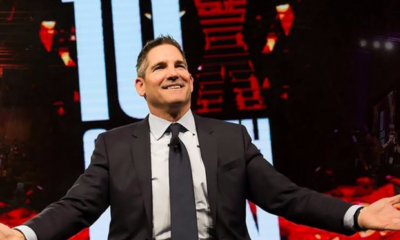Success Advice
5 Powerful Steps To Learn Anything Faster

Put an average joe next to someone of success, and you’ll find that the latter had more knowledge to get to where they are today.
While there’s only so much time in the day to learn new skills, you can accelerate how fast you learn something. Whether you want to learn a new language, real estate, or how to start a business, the person who can learn faster will always have the upper hand in life.
Here are 5 powerful steps to learn anything faster:
1. Method beats hours
When it comes to learning something new, the method will always beat the number of hours you put into something. This isn’t to say that the number of hours isn’t important, but you should choose which method will give you the best results.
For example, let’s say two people were driving from Boston to New York City. It doesn’t matter how skilled or committed the first driver is. If he’s driving a beat up pickup truck, and the second driver has a Ferrari, the first driver will lose.
Your method is the vehicle that will become the engine of where you want to go. With anything you want to learn, there will be dozens of available methods to follow, and “experts” to learn from. This means that you want to spend a lot of time understanding who you’re learning from, what credibility they have, and how it fits with your learning style.
“Money is like gasoline during a road trip. You don’t want to run out of gas on your trip, but you’re not doing a tour of gas stations.” —Tim O’Reilly
2. Apply the 80/20 rule
As a reader of Addicted2Success, you’ve probably heard of Pareto’s Law. It was a concept developed by an Italian economist, Vilfredo Pareto, which explains that 80% of your desired outputs will come from only 20% of your inputs.

While the exact ratio varies from situation to situation, you’ll find that:
- 20% of people in your life will lead to 80% of your happiness
- 20% of your customers will drive 80% of your sales
- 20% of your learning methods will lead to 80% of your results
When it comes to learning, it feels like there’s so much we don’t know, so it’s easy to jump around everywhere. This will only lead to wasted time. What you want to do is focus on the one or two things that will drive the needle for what you want to achieve, and double down on them.
For example, if you’re learning Spanish to travel this summer, instead of learning how to write or read, you should learn how to speak Spanish. Or instead of trying to please a dissatisfied customer that’s only paying you $37/month, you should add 10x more value to a customer that’s paying you $1,000/month.
3. Learn by doing
Immersion is by far the best way to learn anything. And as research shows, it turns out that humans retain:
- 5% of what they learn when they’ve learned from a lecture.
- 10% of what they learn when they’ve learned from reading.
- 20% of what they learn from audio-visual.
- 30% of what they learn when they see a demonstration.
- 50% of what they learn when engaged in a group discussion.
- 75% of what they learn when they practice what they learned.
- 90% of what they learn when they use immediately.
Think back to how you learned to play basketball, ride a bicycle, or swim. Instead of watching tutorial videos or reading a textbook on how to do something, the way to learn faster is to get into the trenches and gain experience through mistakes.
4. Find a coach
From business titans to professional athletes, the people performing at the highest level all have one thing in common. They have a coach.
According to best-selling author, Seth Godin, there are five reasons you might quit in anything you do:
- You run out of time (and quit)
- You run out of money (and quit)
- You get scared (and quit)
- You’re not serious about it (and quit)
- You lose interest (and quit)
Having a coach allows you to see the blind spots that you couldn’t see before, and guide you through the tough times that inevitably comes when you’re learning anything new.
A coach doesn’t have to cost $1M a year, like what Tony Robbins charges, or even $1,000. If you’re trying to learn a language, you could have a language coach you work with. If you’re trying to learn an instrument, it could be finding a private teacher to help you.
The point is, you’re not going at it alone. And having someone that’s keeping you accountable can take you miles further than doing everything yourself.
5. Process over performance
Doing the work is often the hardest thing for most people. A common mistake people make when they’re learning something new is to focus on performance over process. It’s hard to see any consistent results until you have put in a significant amount of work upfront.
For writers, this is sitting down and writing 500-words a day, no matter how bad it may turn out. For athletes, this is waking up every morning and training, no matter how groggy and sore you feel. For language learners, it’s forcing yourself to speak the language everyday, no matter how many mistakes you make or how uncomfortable you may feel.
“Seventy percent of success in life is showing up.” — Woody Allen
Taking small steps may not sound sexy, but it has been the proven path to follow for anything you’ll want to achieve in your life and business.
Which step helps you learn faster? Please leave your thoughts in the comment section below!
Success Advice
Best Interac Casinos Canada 2025 e-Transfer Casino Sites
Best Interac Casinos Canada 2025 e-Transfer Casino Sites
Premium Interac casinos offer 24/7 payment processing, reducing wait times for night-time withdrawal requests. Existing players are included as there’s a juicy loyalty program. Also, eligible players have a 100% match bonus on the first four deposits. This predominantly varies depending on the casino you’re playing with. The sites we recommend on this page offer reliable assurance that your money and details are secure. This is standard for all casinos and if this is not required, it should be a red flag.
Interac Online Casino Withdrawals
Interac uses the same banking system, which means you can get the same level of security. If they do, we immediately go to the banking section and look for the Interac banking logo. That’s worthy of note because the banking limits for these options might differ. Interac is generally a great way to pay when it comes to casinos. Only those Interac casinos that focus on good customer service make the cut.
What we don’t like about Playzilla:
The first deposit is matched up to $400, and the second and third are matched up to $300. One of the most appealing features on the site is the welcome bonus. Each deposit earns you a match deposit bonus that can earn you up to $1500. We’re also big fans of the VIP program that rewards existing players for their loyalty. The whole process of making the gambling deposit in one of your favorite Interac online casinos will take about ten minutes. If you are looking for a native Canadian solution for the casino deposit, here is a perfect option.
List of Casinos in Ontario
We recommend using any of the online casinos we mentioned in the sections above. Since these are top banks which are standing behind Interac it is a completely safe online payment service. As you will see from our review if you choose Interac payment can be made in a safe and convenient way. One can use this https://www.scoobynet.com/group.php?&do=discuss&groupid=89&discussionid=1328 banking method in some of the best online casinos in Canada to make deposits as well as to withdraw money. Instadebit is also a popular payment method at Interac casinos Canada.
Set a Gambling Budget
.png)
We are lucky as Canadians to have the choice to gamble, whether it is with online casinos in Canada or land based ones. We here at Casino Canuck have been gambling long before online casinos even existed. Most casino sites require a minimum deposit of $10, while some accept as low as $5. Bank transfers are widely available at real money gambling sites.
Top Games Available At Interac Online Casinos
See if the online casino has optimised its games and interface for Android and iOS users. After a successful debut in 2025, Fast Slots Casino has become a favourite among Canadian players. Operating with a Curaçao licence, the brand is subject to strict regulatory oversight, which ensures fair gameplay and secure payments for players. Our Del Oro review provides in-depth insight into the casino site to help you understand the platform. Use Interac to set clear bankroll boundaries — treating transfers as a single session budget can help avoid chasing losses.
The games these providers offer are safe and loaded with cutting-edge graphics, innovative gameplay and deep mechanics. If Interac payments are not protected properly, the review stops there. Canadian casinos need from 24 to 72 hours to verify your withdrawal request. Check its promotions page, and bonus terms and conditions, to see if such a feature is available. Firstly, if you make a minimum deposit, some games may not be available to you simply because of the minimum bet size limits. As soon as Interac casinos Canada process the request, they pass it to Interac.
Online gambling is legal when operated by provincial governments or through licensed operators. In Ontario, for example, casinos must be licensed by AGCO and operate under iGaming Ontario. Always choose casinos with verifiable licensing for the best protection and safety.
Success Advice
Psychologia wygranej: jak emocje wpływają na decyzje graczy
Świat kasyn to nie tylko świat rozrywki i szansy na wygraną, ale także przestrzeń intensywnych emocji. Każdy gracz doświadcza mieszanki ekscytacji, adrenaliny i napięcia, które wpływają na podejmowane decyzje. Zrozumienie psychologii wygranej pozwala lepiej kontrolować emocje, planować strategie i podejmować świadome zakłady.

Jak emocje kształtują decyzje podczas gry
Emocje są jednym z najważniejszych czynników wpływających na decyzje graczy. Chęć natychmiastowej wygranej, strach przed stratą czy poczucie satysfakcji po sukcesie mogą powodować impulsywne zakłady lub przeciwnie — zbyt ostrożną grę. Psychologowie podkreślają, że kontrola nad emocjami jest kluczowa dla długofalowego sukcesu w kasynie.
Logowanie i komfort gry w kasynach online
W świecie gier online proces logowania ma ogromny wpływ na doświadczenie gracza. Intuicyjne i szybkie ice casino logowanie pozwala natychmiast rozpocząć sesję, minimalizując stres związany z technicznymi aspektami platformy. Dzięki temu gracz może w pełni skupić się na emocjach związanych z grą, analizie ryzyka i podejmowaniu decyzji strategicznych. Dodatkowo kasyna online oferują narzędzia wspierające graczy, takie jak historia wyników, statystyki i bonusy, które pomagają w świadomym planowaniu zakładów.
Tabela: Wpływ emocji na typowe decyzje gracza
| Emocja | Typowe zachowanie | Potencjalny wpływ na wygraną |
|---|---|---|
| Ekscytacja | Zakład większej kwoty | Może zwiększyć potencjalną wygraną, ale też ryzyko straty |
| Strach | Unikanie ryzykownych zakładów | Ogranicza możliwości, zmniejsza szanse na wygraną dużą sumę |
| Satysfakcja po wygranej | Kontynuacja gry w tym samym stylu | Może prowadzić do impulsywnych decyzji |
| Frustracja po przegranej | Próba „odrobienia strat” | Zwiększa ryzyko podejmowania nierozważnych zakładów |
Strategie kontrolowania emocji w grze
Aby emocje nie przejęły kontroli nad decyzjami, gracze mogą stosować różne strategie:
-
Planowanie budżetu na sesję i trzymanie się go
-
Wykorzystywanie narzędzi analitycznych dostępnych online
-
Stosowanie przerw w trakcie gry, aby ocenić swoje decyzje
-
Korzystanie z bonusów i promocji w sposób przemyślany
-
Świadome monitorowanie poziomu adrenaliny i emocji podczas gry
Podsumowanie
Psychologia wygranej pokazuje, że emocje w kasynie mają ogromny wpływ na decyzje graczy. Świadome zarządzanie swoimi reakcjami, korzystanie z narzędzi analitycznych oraz strategii pozwala czerpać satysfakcję z gry, minimalizując impulsywne zachowania i niekontrolowane ryzyko. Dzięki platformom online, takim jak ice casino, gracze mogą w komfortowych warunkach rozwijać swoje umiejętności, obserwować statystyki, korzystać z bonusów i podejmować przemyślane decyzje, które zwiększają szanse na sukces i pozytywne doświadczenia z gry.
Success Advice
Kiedy liczby zaczynają kierować emocjami
Na pierwszy rzut oka hazard wydaje się światem opartym wyłącznie na matematyce. Procenty, kursy, statystyki i algorytmy tworzą ramy każdej gry. Jednak za tym uporządkowanym światem liczb kryje się coś znacznie bardziej złożonego — emocje gracza, które często przejmują kontrolę w kluczowych momentach rozgrywki.

Liczby w kasynie nie są neutralne. Każdy współczynnik, każda wyświetlana wartość wpływa na sposób myślenia i odczuwania. Informacja o możliwej wygranej potrafi wywołać ekscytację, a seria przegranych — frustrację lub chęć szybkiego odegrania się.
Mechanika liczb a reakcje psychologiczne
Gdy gracz widzi konkretne wartości — wysokość stawki, potencjalną nagrodę czy procent zwrotu — jego umysł automatycznie próbuje nadać im znaczenie. Nawet osoby, które nie analizują statystyk na co dzień, reagują emocjonalnie na zmieniające się cyfry. To one budują napięcie i poczucie ryzyka.
Nowoczesne platformy, takie jak ice casino, prezentują dane w sposób czytelny i dynamiczny, co wzmacnia wrażenie kontroli. Paradoksalnie im więcej informacji otrzymuje gracz, tym łatwiej może ulec emocjom zamiast chłodnej kalkulacji.
Dlaczego liczby potrafią wciągać
Człowiek ma naturalną tendencję do szukania wzorców. W hazardzie przejawia się to w analizowaniu serii wyników i próbach przewidywania kolejnych zdarzeń. Nawet losowe sekwencje zaczynają wydawać się logiczne, co wzmacnia zaangażowanie i emocjonalne przywiązanie do gry.
Każda kolejna decyzja staje się odpowiedzią na liczby, które pojawiły się wcześniej. W ten sposób matematyka przestaje być tylko narzędziem, a zaczyna oddziaływać na psychikę gracza.
Równowaga między analizą a emocjami
Świadome podejście do gry polega na zrozumieniu, że liczby są elementem systemu, a nie obietnicą wyniku. Emocje pojawiają się naturalnie, jednak ich kontrola pozwala zachować dystans i podejmować bardziej racjonalne decyzje.
Aby lepiej zobrazować różnicę między chłodną analizą a emocjonalną reakcją, warto spojrzeć na poniższe zestawienie:
| Element gry | Podejście racjonalne | Reakcja emocjonalna |
|---|---|---|
| Wysokość stawki | Dopasowana do budżetu | Zwiększana pod wpływem impulsu |
| Seria przegranych | Przerwa lub zmiana strategii | Chęć natychmiastowego odegrania |
| Potencjalna wygrana | Ocena ryzyka i prawdopodobieństwa | Ekscytacja i nadmierny optymizm |
| Czas trwania sesji | Zaplanowany z góry | Przedłużany pod wpływem emocji |
Świadomość jako klucz do kontroli
Gdy gracz rozumie, w jaki sposób liczby wpływają na jego emocje, zyskuje przewagę nad impulsywnymi decyzjami. Hazard przestaje być chaotycznym doświadczeniem, a staje się formą rozrywki opartej na samokontroli i refleksji.
Ostatecznie to nie liczby rządzą grą, lecz sposób, w jaki człowiek na nie reaguje. Świadomość tego mechanizmu pozwala zachować równowagę między emocjami a rozsądkiem — a to właśnie ona decyduje o jakości całego doświadczenia.
Success Advice
Greatest Internet casino Usa: Finest Internet sites inside the 2025
Blogs
The new collected information is up coming used to assess the newest casino’s Security Index. It’s a given one an authorized casino instills a lot more trust as it have to operate in the regulations of the provided jurisdiction. Certain certification government actually wanted casinos to go through third-team game research. Betting sites functioning within the particular says are hit-and-miss on the greeting incentives.
The best Online casinos in the united kingdom by Category
Firstly, all of the casino games is actually designed giving our house a keen virtue, and therefore you’re constantly to play getting left behind. You can get happy and you may earn, but it is almost impossible to become winning on the a lot of time work on. Thus, for those who be able to victory, it is certainly better to withdraw their payouts. Because of the reacting about three simple and quick issues linked to incentives, video game, and you will period of web based casinos you want, you’re served with three best gambling enterprises you to definitely satisfy their conditions. Then it is simply a matter of choosing the one which looks far better your otherwise time for record if the you know you want observe more alternatives after all of the.
Blackjack, baccarat, French roulette, and you may craps will be the higher investing games from the local casino websites. You have to know strategy and you may specific choice models to achieve the highest RTP with our game. EWallets such PayPal and you may Neteller provide quick payouts, usually within 24 hours. However, they aren’t usually available at All of us-based casinos, and they have a charge of about step 3% to possess distributions. Borrowing from the bank and you will debit notes are an easy and you will familiar means for withdrawing finance, but not all casinos offer them.
A knowledgeable Us online casinos will be the web sites which have good licenses, which permit them to operate lawfully in the united states. After that you can score the fresh USA’s best on-line casino web sites founded on the online game, bonuses, percentage alternatives, mobile programs, and other key factors. The brand new professionals can start their travel which have an excellent welcome provide. The brand new casino provides lots of special offers and you will respect perks to have the normal participants. Also, which casino site also provides wagering and online casino poker in a few claims. All of these things have triggered the brand new user’s high ranking to your our very own set of an informed online gambling web sites.
Simple tips to Habit In control Playing at the Better United states of america Casinos on the internet
We love exclusive eighties/1990’s Vegas temper on the site, and therefore contributes a vintage contact to the Vegas Today feel. In both-people and online gambling enterprises inside the Canada for real currency features their attraction. Visa and Mastercard is actually generally accepted at the online casinos in the California for both places and you can withdrawals. Specific harbors is private to certain Canada web based casinos on account of sales produced amongst the operators and game designers. Reload incentives try a common strategy during the Canadian web based casinos, built to keep you motivated to make additional places immediately after stating its invited incentive. When shopping for a knowledgeable commission during the an on-line local casino, it’s crucial that you go through the slots’ advice.
- If a keen operator’s software is accessible via mobile phones, professionals can access a common video game each time, anyplace.
- If you would like swift winnings, extra shelter, otherwise anonymous transactions, you will find a safe payment method of suit you.
- As you’re looking at commission speed, its also wise to go through the number of payout procedures you to definitely appear.
- Overall, an informed web based casinos provide an incredibly comparable experience so you can actual, brick-and-mortar gambling enterprises.
- It’s a different day and age out of playing which is reshaping the new landscape out of activity regarding the Hill County.
- We only give you an informed on-line casino internet sites — as well as the fresh casinos which have made it to our finest rated online casino listing are smart all the-rounders.
It is very important just remember that , RTP may vary across the some other online casino games, and therefore a good casino’s RTP is short for the typical of all their games. Gaming.com recommendations all-licensed casino other sites in order to focus on what kits them apart and provides devices and then make contrasting him or her simple. The casino review try carefully facts-appeared and you will confirmed because of the we of benefits just before guide. We constantly upgrade ratings to keep advice direct, related and up-to-date, adhering to reveal remark strategy and you will article policy. It is extremely important to strategy online gambling inside the a safe and you can in charge method. To quit shedding target to gambling addiction, we advice your comprehend our very own writeup on simple tips to enjoy securely.
You can examine if your gambling enterprise try legit utilizing the UKGC’s searchable public check in to look in the license count. And while your’re there, see if they previously acquired any penalties from the UKGC. This is why we’ve picked to help you highlight a premier-tier Uk gambling enterprise that have an advantage that offers you something additional. Sure, modern jackpots is a part of gaming activity and see harbors which have that one. A few effortless resources will help you to are still aware and you can create your video game for cash reliable.
This lets you decide on the fresh commission method that suits your must-haves to possess rate, functionality, and you may charge. Demo gamble allows you to is harbors, blackjack, roulette, and prior to depositing and you will establishing wagers. Unfortunately, not all gambling enterprises provide demos, and this for a lot of may be a deal-breaker. And given prompt casino earnings without ID monitors, you should also make sure that a casino on the internet to the finest payment handles its site and pro money. Seek out a good padlock from the address club to confirm one to a casino webpages try encoded.
Greatest Online casinos A real income
While the payout speed raise, evident Us iGaming players will be consider often to see which iCasinos provides upped its games. You will find an educated online casinos Us houses right here at the OnlineCasinos.com. You can gamble with confidence from the all of our required web sites, understanding i simply focus on the best of an informed. Near to the gambling pros’ in-depth ratings, we trust current user reviews and quantitative local casino analysis items to send by far the most unbiased, trustworthy, and you will outlined assessments. AMEX is frequently thought to be one of the most secure and overall greatest fee tips within the Canada and you will beyond. It’s convenient to use but not usually supported by casinos on the internet within the Canada, and you may not since the common because the Visa otherwise Bank card.
-

 Did You Know4 weeks ago
Did You Know4 weeks agoThe Success Patterns You Inherited (And Didn’t Notice)
-

 Entrepreneurs3 weeks ago
Entrepreneurs3 weeks agoThe Essential Skills Every Entrepreneur Needs In 2026
-

 Business4 weeks ago
Business4 weeks agoThe Hidden Money Pit in Your Operations (and How to Use It)
-

 Change Your Mindset3 weeks ago
Change Your Mindset3 weeks agoHow to Turn Your Mind Into Your Greatest Asset (Instead of Your Enemy)
-

 Change Your Mindset2 weeks ago
Change Your Mindset2 weeks agoThe Silent Skill That Makes People Respect You Instantly
-

 Life2 weeks ago
Life2 weeks ago10 Research-Backed Steps to Create Real Change This New Year
-

 Tech2 weeks ago
Tech2 weeks agoWhat’s in a Name? How to Get Your Domain Right
-

 Did You Know1 week ago
Did You Know1 week agoHow Skilled Migrants Are Building Successful Careers After Moving Countries
























5 Comments